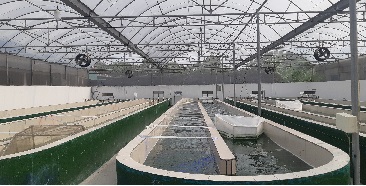The Center for Research and Development of Microalgae Biotechnology (IRDM) under the Faculty of Biotechnology, Vietnam National Academy of Agriculture is one of the units implementing application and development of technological processes for microalgae culture. The center currently holds more than 50 different species of microalgae, many of which have potential applications as functional foods, unsaturated fatty acid extraction, and species capable of large-scale production. to collect biomass. Currently, the center has 2 main algae farming models: Race-way tank and Photobioreactor (PBR).
Raceway tank

The center has built a raceway system at a scale of 100 m3 to test algae farming processes on a commercial scale, evaluate the ability to grow and replicate in reality and to perfect the processes. microalgae culture technology.
This technology consists of 5 tanks, these tanks are built in a closed greenhouse environment with a fully automatic system. Each tank has a stirrer system that is automatically installed at different times of the day so that the algae can be dispersed evenly in the tank, not focusing on one area to increase the quality of the fresh algae.
After a period of 2-3 weeks, collect biomass once. Algae biomass after collection can be used directly as fresh algae products (frozen storage) or dried at low temperature to create raw materials to develop products in the form of capsules, tablets or as raw materials. materials for the extraction of biologically active compounds for use in pharmaceuticals as medicinal drugs or cosmetic chemicals.
Photobioreactor (PBR)

With a closed propagation system (photobioreactor) that is tightly controlled in terms of nutrients, light, pH and temperature, the Microalgae Biotechnology Research and Development Center is capable of multiplying many types of microalgae strains. algae on a large scale with 100% purity and no contamination.
To ensure that microalgae strains are reared in the most optimal conditions, especially in terms of light and temperature because algae synthesize substances necessary for the body through the process of photosynthesis, the All biomass plants in the greenhouse are equipped with sensor systems, with the ability to measure environmental parameters such as temperature, humidity, light intensity.
From the information recorded continuously from the sensors, the grid system will automatically pull out or retract, and the pump and water injection system to cool the Photobioreactor system ensures the light and temperature indicators. The temperature in the culture area is always maintained within the suitable range for algae growth. In addition, on the basis of synchronous design, sensors for pH, temperature, concentration of O2, CO2 … can be applied to measure changing parameters right inside the glass tubes of the Photobioreactor system.
The information from the sensor system is converted into digital signals and transmitted to the central processing system by wireless internet technology. From here the signal is connected to control applications installed on smart devices such as mobile phones and computers. Thanks to that, the staff of the Center can monitor the evolution of technical parameters in the farming area at any time and anywhere, and can control it right on their smart device.
And finally, the biomass is collected using a membrane filter with a small pore size. Biomass is preserved in frozen or dried form to powder or stick form. With the current conditions and capacity, the Center is capable of providing algae seed for units at the scale of 5000 liters/time of seed delivery.
